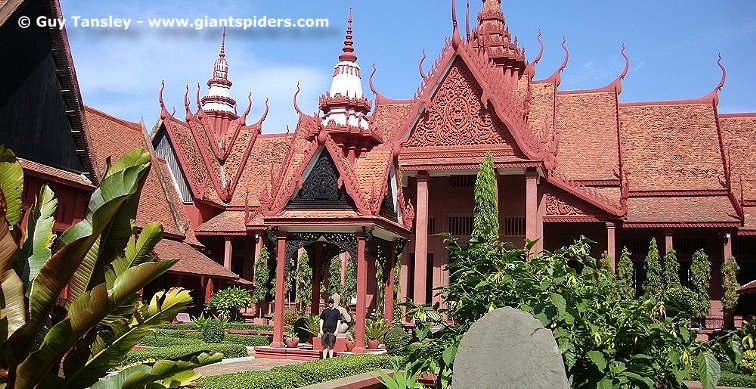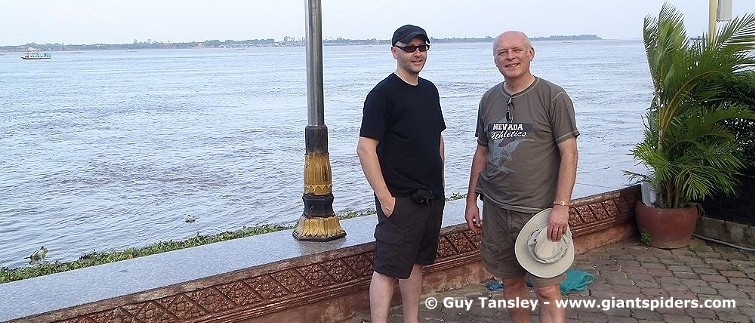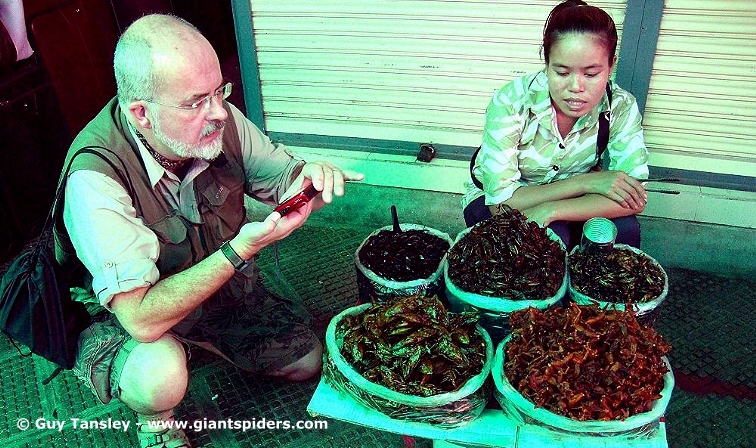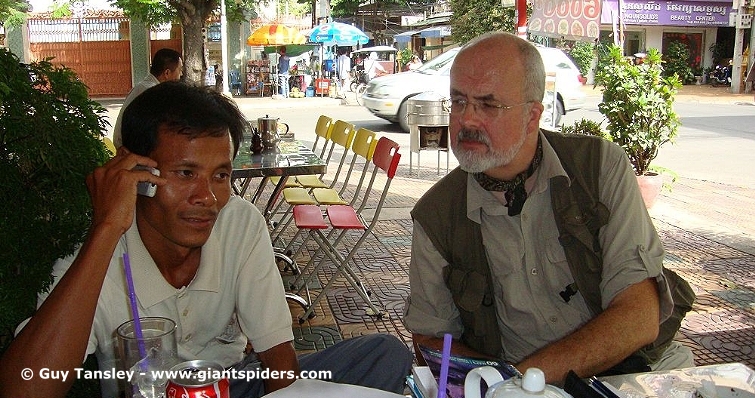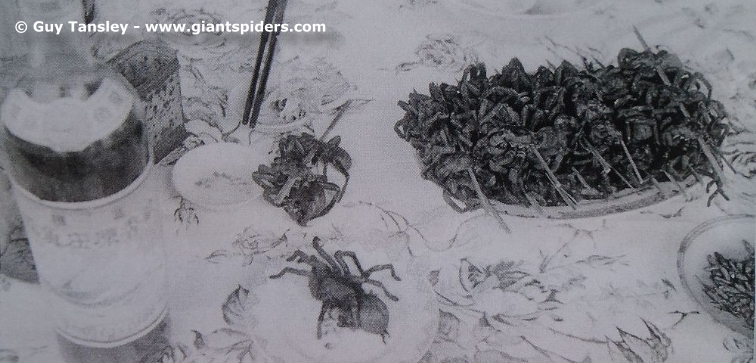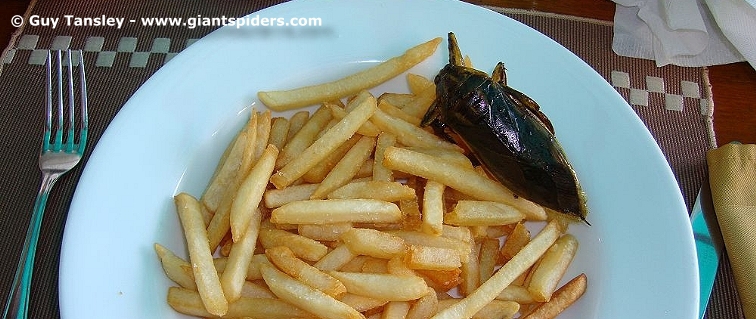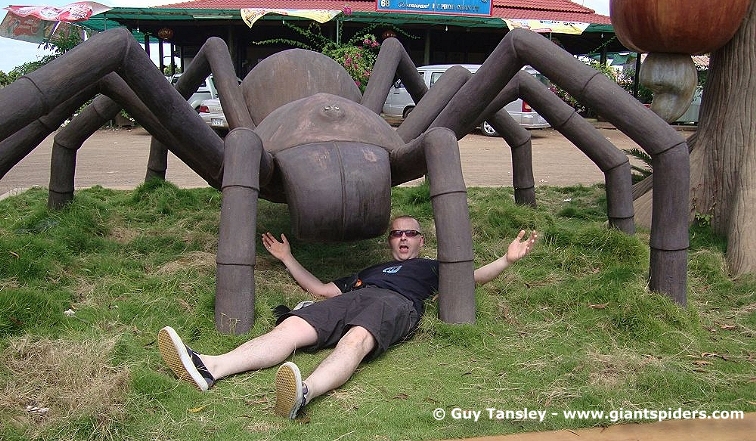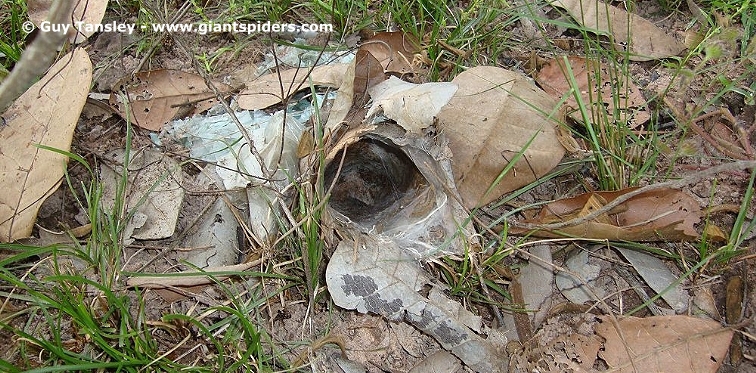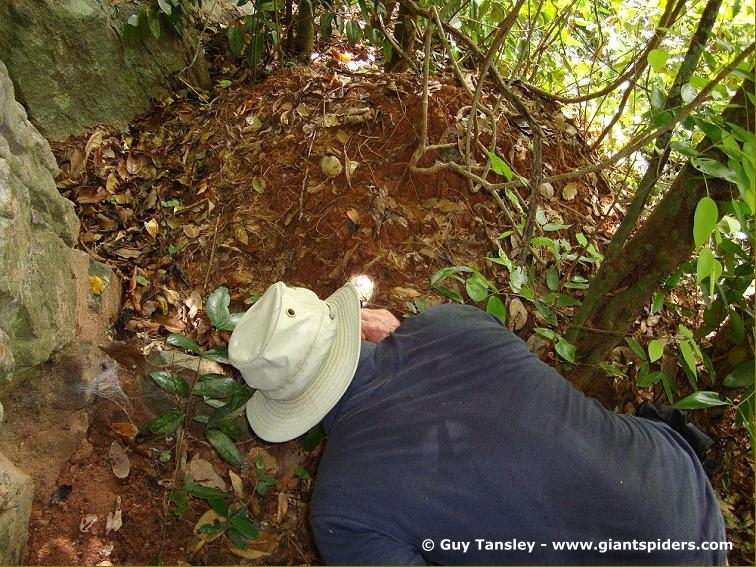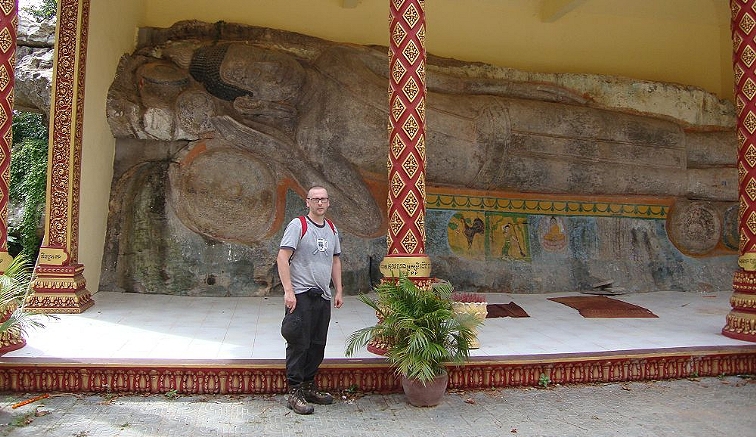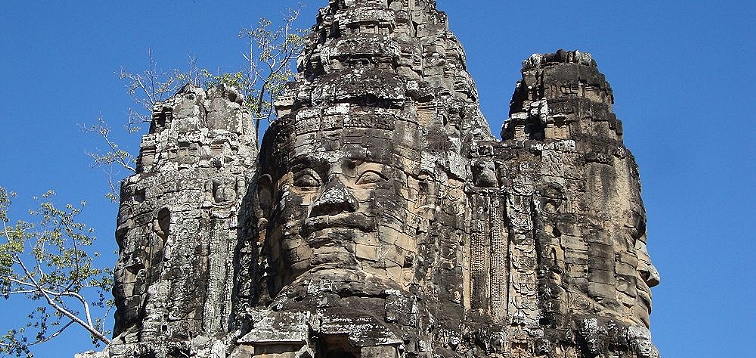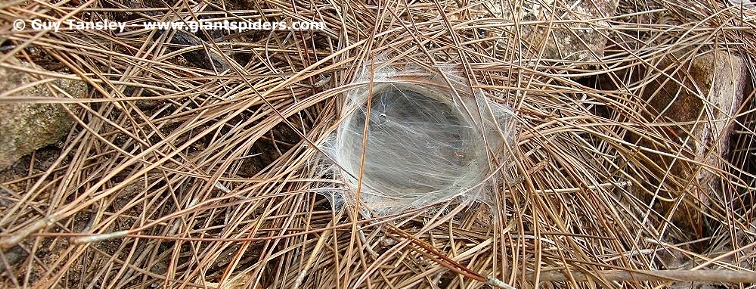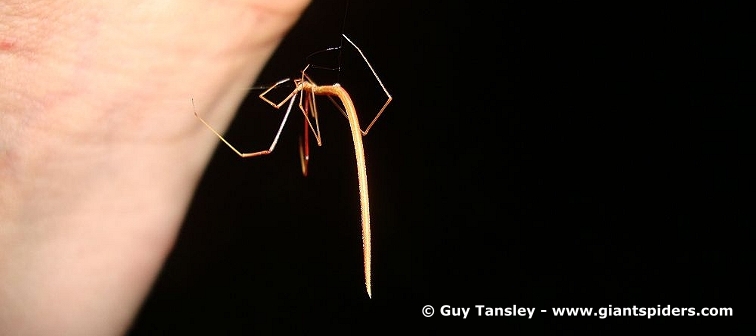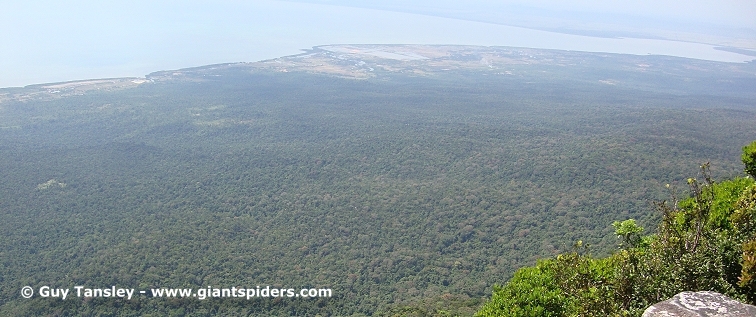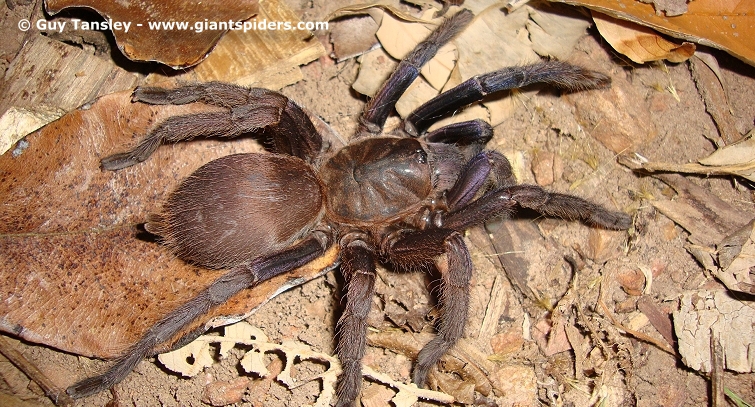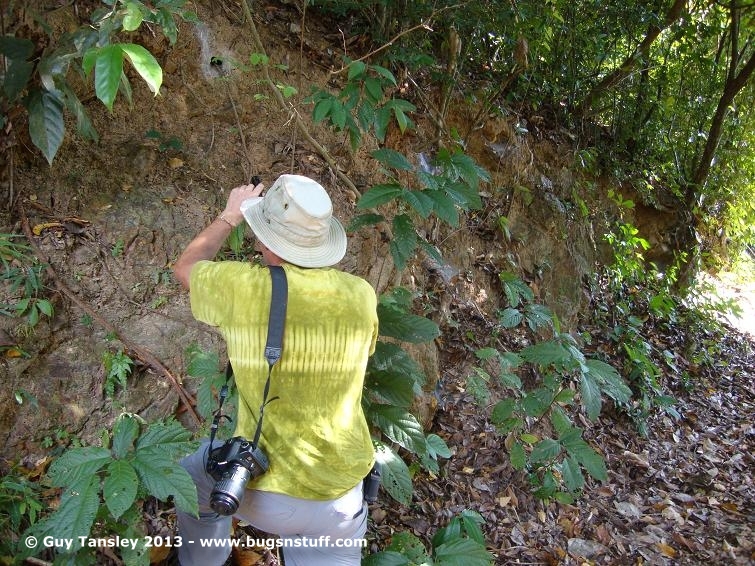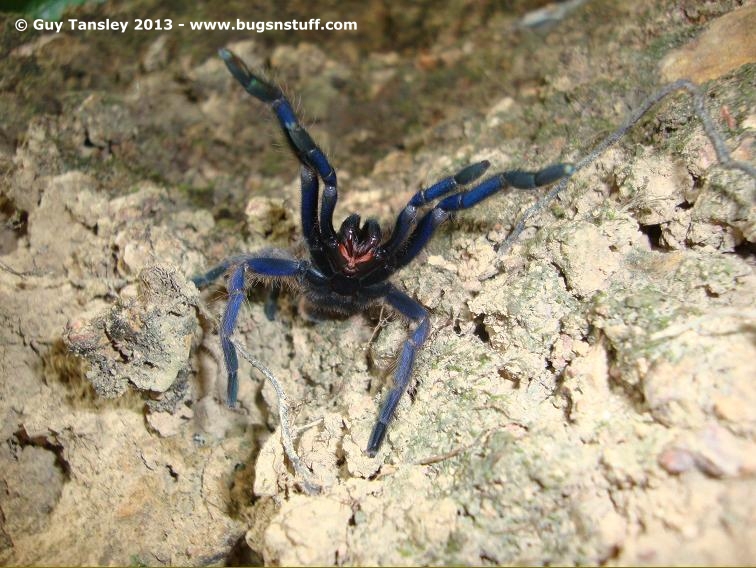
20 Days in Cambodia (is eating tarantulas sustainable?)
Guy Tansley
During November and December 2011, I travelled with Andrew Smith and Paul Carpenter to discover the origin of tarantula eating in Cambodia. The following article is adapted from my
diary notes.
Day 1: Jude dropped me off at Newcastle airport at 13:00 for the 50 minute flight down to Heathrow. Transfer to terminal 3, checked bag then met a much relieved Andy and Paul in the Heathrow
departure lounge. They were amazed at my lack of concern arriving only 2 hours before departure but I assured them that there were no worries and after all, I'd arrived will time to spare hadn't
I?
11.5 hour flight to Hong Kong without any problems. Two hour wait in Hong Kong before the 2.10 hour flight into Phnom Penh. Some relief after spotting Ben We (our driver for the duration) and pleased
to see we had a somewhat roomier car than expected (Toyota Camry). We wound our way, or rather the other traffic, (mainly mopeds) wound THEIR way around us on the roads while Andy quizzed Ben about
the spiders we were likely to see in the area.
Ben assured us that fried tarantulas could be seen and bought around the city centre but in particular outside the King's temple. Ben himself lived in the centre and had ran his taxi company for
around 15 years. Strangely, during his childhood in the rice paddy fields east of Phnom Penh, he had never seen a wild tarantula or 'ah-ping' as the locals referred to them.
We piled our bags into the boot of the car and headed to a hotel that Andy had spotted in the Lonely Planet guidebook. I remained in the car while Andy and Paul tried to get us a good price but to no avail so we headed to a hotel recommended by Ben and we struck lucky. The Imperial Hotel
was just the job; air conditioning, restaurant and bar, pool and most of all, free wifi!
A quick check-in was followed by a light dinner as it felt like we had been eating all day on the flights. I went for won ton soup, Paul tom yam soup and Andy, French onion soup all helped down with
3 pints of draught Tiger beer. The restaurant was empty apart from a couple of French guests and as we finished our beers and complimentary peanuts, Paul and I headed up to the hotel room leaving
Andy in a cloud of cigar smoke (carefully chosen in Hong Kong airport duty free), bats and the sound of tokay geckos writing up his notes for the day.
Day 2: Woke up after not much sleep due to Paul's intense snoring and Andy's weak bladder! Time to break out the industrial earplugs tonight! A decent view of the fast flowing Mekong River outside
the hotel room too. After a chilli omelette for breakfast, Ben picked us up at 10:00 and we headed a short distance to our first tourist stop, the Genocide Museum.
This was quite a sobering experience on many levels. Graphic images of torture victims and the school setting making it all the more relevant. We spotted an interesting
image of a large centipede being used in torture and the net cages with holes for prisoner's hands to go inside. Paul had quite a hard time at the museum as did Andy but with his teacher/historian
background, he found it easier to take pictures throughout. I was uneasy but believe that these images of terrible events must be seen to appreciate others
circumstances.
The Scolopendra image (left) and the centipede torture cages (right)
Next Ben took us to the National Museum which was impressive on the outside but less so on the inside. Lots of Buddha statues and glimpses of Angkor Wat that made us eager to visit. Andy was disappointed as he was hoping to see some spider reference in their artefacts.
The National Museum
Outside the museum we learned that Ben's car
had broken down so Ben's colleague, Terry, collected us and dropped us off outside the King's Palace. Terry gave us additional spider information (including the name 'buffalo spider') and the
location of the only restaurant in the capital to sell fried tarantula on their menu.
After a short stop-off in a cafe for Chinese tea on the banks of the Mekong River, we walked along the riverside in search of this restaurant. Several wrong turns and close calls with the traffic
later, we eventually found it. It seems pedestrians are the lowest importance on the roads here. Drivers aren't hostile to pedestrians but the pedestrian crossings are totally ignored and the only
way to cross the roads is to choose your gap wisely and simply go for it! The traffic doesn't flow particularly fast around rush hour and the moped drivers are used to people walking across the road
so generally speaking, although a hair-raising experience, it isn't particularly dangerous.
Guy and Paul on the banks of the Mekong River
Inside the quiet but rather plush (by Cambodian standards) restaurant we were shown to our table and for the first time the spiders were referred to as 'tarantulas'. Obviously there are a lot of tourists that come here to eat spiders (no doubt for the novelty factor) so tarantula had become a popular term for the waiters. We quizzed the waiter on the availability of the spiders and asked if they had any live tarantulas and he left to check. In the meantime we ordered beers and discussed the repercussions of 3 BTS members being photographed eating tarantulas! The waiter returned and told us that no live spiders were available but they had some pre-cooked and ready to re-fry. We asked and were allowed to see the spiders in the kitchens and Andy took photos of the waiter holding the plated spiders. The kitchen was clean and the waitress made sure that our photos were for personal use only.
Guy and Paul outside the restaurant (left) and the restaurant waiter with fried tarantulas (right)
We returned to our table and within a few minutes the waiter brought us our tarantulas. 3 adult deep fried spiders were arranged on the plate with leafy garnish and a pepper dipping sauce. Without much hesitation, Paul and Andy tucked in while I shot photos and video of the experience. The taste was hard to pin down but it didn't taste like chicken as is often commented. There was a nutty taste but this was probably down to the peanut oil the spiders were fried in. I took my first bite of my spider which looked like an adult male. The taste was quite pleasant but most things are when they're deep fried so we finished off the lot. The spiders were fried in lime and chilli sauce and were $4 for a serving of 3.
Deep fried tarantulas with pepper sauce (left) and Guy takes his first bite (right)
A discussion with the waiter revealed
some interesting information. The spiders are ordered as and when required and their contact (a woman), simply places them on a local bus bound for the capital and they are dropped off at the
restaurant. Between 100 and 150 live spiders are ordered per week when needed. The fang tips are removed and during a period of shut down at the restaurant, live, un-bought spiders were released into
the restaurant gardens but they weren't seen again. We obtained the telephone number of the spider woman contact for later in the trip and more info of people selling them on the
street.
A dinner of noodles and healthy debate followed and we headed off to bed looking forward to the early
start the next day.
Day 3: Another omelette for breakfast then off to the local food market to search for various bugs for
sale. Somewhat disappointingly there were only two that day, one selling water bugs and the other silk worm cocoons. Photos were allowed if we agreed to buy some bugs so we obliged. A wander around
the very clean and quite small (for the capital) markets followed.
Andy with a market seller
Ben then took us to the Killing Fields Memorial where we each took an audio tour for $5. We spent over an hour at this small site and sombrely walked through the excavated and now over-grown, mass graves before ending up at the main Memorial building filled with the bones and skulls of the deceased. A small museum is also on site and a shop where we saw bottles of spirit containing both small cobra and scorpions.
Killing Fields Memorial (left) and skulls inside (right)
During a Coke break, Ben called the spider woman contact number from yesterday and we tried to organise the next day's events. Ben was shocked to hear that the women was willing to arrange for us to see the spiders in their natural habitat but when she said she would charge $100 Ben suggested that we could easily visit this area without her help.
Ben talks to our contact
Next we visited the local reference library and with a little help from an archivist there, we found images of fried spiders taken by a photographer called Mimijac Palgen sometime between 1940 and 1962. This confirmed that the locals didn't start eating fried tarantulas as a result of the Khmer Rouge as is sometimes suggested.
Photo found in the archives
We returned to the hotel to prepare our day sacks for the following day and have a light lunch of beer, water bugs and chips!
Water bug and chips anyone?
Following a brief power nap back at the
hotel, we returned to walk along the riverside in search of ah-ping sellers but to no avail. There were one or two vendors with bugs but no spiders. It may be that the tarantula eating experience
isn't actually that common and I suppose it was a good sign that they weren't selling spiders everywhere.
The riverside area was a busy place. Lots of traffic (that we had to weave through to cross the road
again) and a few groups of locals participating in group fitness exercises to loud music. We made assumptions of other Western men walking around the area as 'dirty sex tourists' then realised that
everyone else was probably making the same erroneous judgements against us!
Tom Yam soup for dinner, final packing arrangements for tomorrow sorted, we retired for the
day.
Day 4: Fried egg on toast and croissants for breakfast then we hit the road to Skuon (pronounced skun)
or 'Spider-town'.
Just south of Skuon we stopped at one of the several truck stops and took photos of us standing next to
two giant concrete carvings of tarantulas and cashew nuts (this area is known for its cashew plantations). We were approached by a couple of locals and after chatting to Ben and discovering why we
were there, they took us a short distance across the road into a rubbish strewn area of land to show us our first large tarantula burrow going straight down into the ground and off to the side. Andy
went to work on the burrow while Paul and I searched for more. We found at least one other but it looked empty.
Guy poses with the giant spider!
Andy and Paul at the burrow Andy's equipment
We learned that the local tarantula extraction techniques involve sticking a glob of rubber on the end of a grass stalk, feeding it into the burrow and when the spider bites this
glue and becomes stuck, they can be pulled out. Another method was to pour gasoline down the burrow to flush the spiders out.
After a failed attempt at tickling the spider out, we asked the locals if they could extract the spider by digging. This meant we could document the process and also meant that we didn't have to do
the digging ourselves! The temperature by then was 42oC and the location of the burrow offered no shade. While the local woman dug out the spider, Paul and I continued our search of the area.
After some time we returned to find the spider had been extracted (scooped out by hand by an older man) and deposited, as is traditional, in an empty water bottle and placed in the car. We learned
that across the adjacent road (where up until 1995 there was original forest) the spiders were abundant but since the area was cleared for both cashew plants and in between these grew pineapples,
they were no longer there. They confirmed the name' buffalo spider' as a traditional name but also mentioned another 'red spider' that was collected and eaten but this one was less common. It was
later confirmed that this extracted spider was an unidentified Haplopelma sp.
We then drove a small distance closer to
Skuon to a similar truck stop and met with several of the locals selling fried spiders. These women carried large plates of fried spiders piled in pyramid fashion around the area for tourists and
locals alike to buy. We paid them a few dollars each for information regarding their wares and they answered a lot of our questions.
It seems around 10 years ago the spiders were collected around Skuon but in recent years they were
supplied from further north around Kampong Thom indicating that as collecting increased, they had to extend their search further a field. Each seller claimed that they fried the live spiders in the
morning and as many as 150 were sold by the end of each day. The retailed at 50 US cents each. The women sellers had both fried and live spiders with them. The live spiders were kept together in
medium sized buckets (that doubled up as a seat) on a few plant stalks so they had something to cling to. Their fang tips had been snapped off and this, combined with them being removed from their
burrows, meant they were very docile and didn't try and bite when handled. We surmised that the spiders could be kept alive quite some time in this condition ensuring a fresh supply (with only the
tips of their fangs removed, they weren't going to bleed to death). We shot video of the interview and took pictures with the live spiders on our hands to prove their
docility.
As we had gathered more information than
expected, we decided to continue north to Kampong Thom instead of staying in Skuon as originally planned.
1.5 hours or so later we stopped approx. 20km outside of Kampong Thom to survey another cashew
plantation. This area was basically a roadside toilet stop for the locals but there we spotted a small herd of water buffalo, ideal for stock shots! Ben asked the nearby herder if he had seen
tarantulas in the area but he said no. Nevertheless we searched and the very same herder pointed out a burrow to Paul and asked if it was what he was looking for. Paul called Andy and me over and we
were delighted to see a large burrow opening with an impressive silk turret which incorporated the dead fallen leaves of the cashew plant. We took photos and cleared the site slightly so we could
return for some night work the next day. A further search revealed another similar burrow nearby in the rubbish-strewn ground. This was marked to be returned to later also. We tickled both burrows
and were tempted by the sight of the spiders but we couldn't confirm that these were the same species found around Skuon.
A large turreted burrow
Ben then drove us into Kampong Thom where we found a small Chinese hotel and booked ourselves in for the next 3 nights (around $70 in total for all three of us). A few beers in the
bar across the road and then dinner in the larger hotel nearby we initially tried to book when we first arrived. The reason for this hotel being fully booked became clear when a stream of 40 or so
British women appeared for dinner. Andy learned that they were on a charity bike ride and they were shocked to hear that we were in Cambodia to see spiders! Not as shocked as us to see who was
fronting there charity bike ride - UK TV celebrity Fern Britton!
"Who?!" asked Andy of course!
Day 5: Another omelette for breakfast then we set off north east of Kampong Thom to the Sambor Prei Kuk Temples. As we drove north and left the main road for a smaller red dirt road, we passed
through many shanty villages with houses on stilts. Paddy fields surrounded these very flat areas and as we progressed, the trees became denser and the forest would soon take over as we neared the
temples. The temple area had three sites with crumbling temples that predate Angkor Wat so we split up and spent 2 hours searching the site. Ben dropped us off at the furthest temple from the
entrance and we were to work our way back within 2 hours. The temple area was in protected, undisturbed forest and immediately we began to see more interesting invertebrates than before. Medium
sized Nephila, Gesteracantha and Argiope orb weavers, Cytropholis webs and countless other insects such as brightly coloured assassin bugs, termites that tapped their heads against fallen leaves as a deterrent and trails of small black and
large red, weaver ants. There were also several small lizard species that scurried underfoot.
The ground was primarily loose sand so we assumed this was no good for burrowing tarantulas so we concentrated our efforts on searching the many large and different surrounding trees. Macaques ran through the trees and cave crickets infested rotting tree stumps but an arboreal tarantula-find evaded us. After around an hour of searching, I met up with Paul and we investigated a nearby temple of impressive proportions. Inside was a giant chimney stack with a place for offerings and outside, the crumbling remains we're fighting a losing battle of being swallowed up by the surrounding forest. Two large lion statues adorned the entrance also.
We focused our attention on the brickwork as the many crevices could easily support and burrow and as Paul circled one way, I went the other. Just to the left corner of the entrance, I spotted some white silk at ground level between two bricks and took a closer look. The silk looked thick enough and when I shone a torch, I could see there was a distinct silk veil across the opening. The hole was approx 5 cm in diameter and after calling Paul over, he confirmed it as a tarantula and said he could see the spider in the left hand section of the retreat. I took another look and there she was. Hidden by silk but a distinct brown colour, we guessed that it may be different from the other 'buffalo spiders' we'd seen on the previous day. I was a happy man and we took many photos of the burrow and surrounding habitat.
Temple retreat close-up (left) and the 'red spider' revealed (right)
Andy was nowhere to be found so we spent another 30 minutes searching the surrounding area but to no avail before heading back to the park entrance as previously planned. Not far
down the track, Paul spotted think silk around 6' from the ground on a snapped off branch on a tree. Inspection with the endoscope revealed a sock web extending down a few centimetres but as the
branch was too high, we needed to find something to stand on to inspect further. It was nice to work in the shade for change also.
We headed back to the entrance and found Andy drinking green tea. He told us he had been led to an area near the first temple where spider burrows could be found but when he got there he found
nothing but empty dug out burrows around 27 in number. After a quick cold drink we arranged for Ben to take us back down the track in the car, first stopping at the silken branch before the temple.
Ben backed up the car so we could stand in the open boot and take a closer look. Inside revealed a small huntsman spider unfortunately!
Moving onto the temple, we pointed out the tarantula retreat to Andy who went to work taking readings etc. while we discussed who would try and get the spider out. Paul said it was up to me but I
bowed to the more experienced and we settled on Paul to do the extracting.
The retreat had two entrances/exits within a few centimetres of each other that seemed to be semi circular in shape. Luckily this turned out to be case and as Paul pushed a piece of grass into the
right side, the spider moved but didn't have anywhere to go. Paul removed the debris using forceps and out came an angry 5" spider grabbing onto the forceps. It was brown in overall colour and
completely different from the 'buffalo spiders'. We concluded that this must be the 'red spider' the locals were talking about. This spider was later identified as
a Chilobrachys sp., possibly C. dyscolus.
After several photos of this spider we once again drove north-east to check out another area recommended to Ben by Skuon locals. Around an hour later daylight was running out so we stopped short of a
small village and searched another cashew nut plantation that had been recently cleared but to no avail. We turned around and headed back to the hotel and nearby restaurant for an early dinner and a
few beers. Andy picked up a bottle of local palm rum and we chatted on the balcony about the problems and pleasures of running rainforest workshops.
Day 6: Ben drove us the short distance south to the Wat Phnom Temple. Andy took the 850 stairs up to the temple with Ben as he wanted to talk with a resident monk about possible spider gods. Paul and I walked a short distance up the
temple road but we soon found a water run-off path that left the road and entered the dense forest. The path soon became a local trail that was almost indiscernible in parts but we knew if we kept on
climbing, we'd soon reach the temple. As usual, we scanned the ground and trees for burrows but the climbing was hard going, spending most of the time watching our footing. After 30 minutes or so
Paul struck gold and found a large burrow entrance going horizontally into a small termite mound. The entrance was silked over and shining the torch inside, we could see the spider. Paul tickled the
entrance and the spider responded by chasing the grass stalk out of the entrance but was unwilling to emerge completely. Initial glances indicated an arboreal species as the metatarsus looked quite
large. We scanned the surrounding forest for a little longer looking for other burrows but found nothing. We did find what looked like a juvenile burrow of the same species but when dug out, the
burrow was inaccessible. Paul also inspected a small tube web about 6' off the ground but the silk didn't look quite right so we returned to the original burrow. A second tickle later, the spider
responded again but still refused to emerge. We got a closer look this time and confirmed that it was probably the red species from yesterday. A quick insertion of the endoscope confirmed this as it
had characteristically long spinnerets. The burrow was deep and efforts to dig the spider out were fruitless so we carried on upward in search of more burrows.
Paul investigates a burrow
Scrambling out of the dense, hot and humid forest, we found ourselves back on the staircase around two thirds up. We scaled this section of stairs and after stopping for a Fanta break, we radioed Andy and he came downthe short distance to meet us. We photographed an impressive view from this point before Paul and I headed up the short distance to the temple leaving Andy to try and figure out a newly discovered panorama function on his camera!
Paul and I did the tourist thing and photographed the temple and reclining Buddha carvings before meeting back up with Andy. Andy showed us pictures of a large silked burrow in the rocks at the top but he decided extraction wasn't an option due to its location.
Guy with the reclining Buddha
As we moved further down the winding mountain road several more similar tube webs were located all in similar positions on the trees. Most yielded
nothing but one I found revealed a medium sized grey coloured spider that responded well to being tickled but would not be extracted. Luckily another empty retreat contained a moult skin so this was
collected for examination later. Initially we guessed that this was the juvenile of the red species but as we discussed burrow entrance comparison with the earlier juvenile burrow and retreat
position, I was of the opinion that this could be a different species. Moving on, Paul inspected a water hole (a possible bomb crater?) and found another similar sock web but this time it was on the
side of a termite mound. Tickling revealed nothing and digging proved too difficult after a good effort by Andy we soon hit the road again and it wasn't long before we were back at the sites
entrance.
A quick Fanta break and an interview with a local woman that used the collect spiders 10 years ago revealed yet more answers to the spider eating tradition.
10 years ago, she claimed that she could collect up to 6000 spiders in the local area but as the years past, their numbers declined from 1000's to 100's and as the competition grew, the profits fell
and it wasn't worth her while anymore. She said that the main ones collected were the buffalo spiders and the red ones, less so. During the wet season when the ground flooded, the spiders evacuated
their burrows and climbed the trees to escape the water which made them very easy to collect.
She said she had managed to locate a nearby burrow while we were on the mountain and took us to it. Unfortunately it was a sheet web spider and not a tarantula burrow so with that, we thanked her and
headed to visit the nearby silk farm.
The small silk farm run by an American Vietnam war veteran (who was away) and his Chinese wife since 2007. It was on a small scale but we all purchased souvenir scarves and were treated to the best
cup of coffee we'd had since arriving!
We drove the short distance back to the hotel, showered, had dinner and discussed the plans for the final day in that area tomorrow; surveying the nearby sight of the turret tarantulas!
Day 7: Today we returned to the cashew nut plantation south of Kampong Thom to investigate the turret burrows we'd found and marked previously. Paul and I systematically paced the area searching for
more burrows than the previously marked two while Andy walked the chosen section and sketched out a plan of the area in his notebook. It took a while for us to get our eye in with these burrows as
they were we'll hidden. Paul and I tried as best we could to follow the lines of cashew trees, walking first one way and then the other just in case the turret was facing in a different direction to
which we walked. Paul spotted the first and after walking the designated area, we hadn't found any others so we walked the short distance back across the road for a cold drink.
Resuming after an hour break, (a local women said she had never seen tarantulas in this area) we checked outside of the original designated area and it wasn't long before the burrows started turning
up on both sides of the path. Ben swept loose leaves aside with a stick and this method proved useful as the silked leaves remained, exposing the burrow. We joked that a garden leaf blower would be
useful here and once the burrow found, switching it to suck to extract the spider would also work! Once we located a new turret, we marked the tree with a piece of debris that was all too common in
this area. Polystyrene food trays, plastic bags etc. were in abundance in this area that could only be described as a toilet stop at the side of the road. Andy worked his way around the burrows
recording all the relevant data, temperature, turret direction and GPS reading etc. At one point, I guided Andy to a burrow that I thought Paul had found and marked the branches above with a plastic
bag but Paul was surprised and told us that he hadn't used any plastic bags and it was pure coincidence that this new burrow had a plastic bag caught in the above
branches!
13 burrows in total were discovered and as the light was starting to fail, we decided that we would have to start digging one burrow soon. Paul and I tickled burrows and were
impressed by the spiders that emerged to attack our grass stalks but none of the spiders would come out far enough to be easily extracted. We sent Ben across the road for a cold beer each and when he
returned, we were joined by a couple of local curious children for a short time. Luckily they soon got bored and left as we wanted to keep these spiders location as quiet as possible!
We returned to an accessible burrow and contemplated digging but we stopped for a short break while Andy phoned home. Meanwhile Paul and I decided to try tickling some nearby burrows to hopefully
avoid the need for digging. All of the spiders responded to the tickling but when the first one came out Paul tried to block the entrance but it quickly ran back down its burrow. The second did the
same so we opted for forceps over the simple twig. The third spider was successfully extracted using the forceps and a water bottle placed over the burrow entrance but somehow the spider pushed this
aside and again, it was gone. The next was successful, however. Using the same method, Paul expertly placed the forceps behind the spider and with a quick but gentle flick, it was out while I sealed
off the burrow preventing escape.
The extracted tarantula was impressive! Olive-green carapace, greenish-brown forelegs, dark brown/black bushy rear legs and a stunningly striped and mottled abdomen. Securing the spider in a split
open water bottled, we headed back to find Andy busily digging up a burrow and told him not to bother as we had already had a specimen. These spiders were later identified
as Cyriopagopus
longipes.
C. longipes at burrow entrance (left) and C. longipes extracted (right)
Too many photos later, we prepared for dusk and hopefully some images of the spiders outside of their burrows after dark. We each settled down at a different burrow and eagerly
waited as night time drew in. It wasn't long before my spider made an appearance at the burrow entrance but sadly it never emerged fully, deciding to sit and give itself a good clean instead. Paul's
spider was already out so he managed to get some good shots and Andy the same (with some tickling involved).
With the photos in the bag, we headed back to the hotel for a well deserved beer and dinner. A final treat of a large tokay gecko above our balcony ended the day and we retired in preparation for the
following days drive north to Siem Reap.
Day 8: We drove around 2.5 hours north towards Siem Reap. We stopped off at the small land mine museum and moved on to the butterfly farm which we decided not to go into as they didn't have any
spiders and it looked quite small. We drove on to our hotel in the centre which was very nice but a little too nice! An afternoon stroll around the town revealed too many tourists for my liking and
beggars which were polite at least. Andy continued his tour alone while Paul and I returned to the hotel with more chilled beers, complaining that the hotel was just too bloody nice! We found a
restaurant later that night which served Khmer food and after a short stroll through the night market, we resisted all offers of a four hand massage (honest!) and retired in preparation for the long
day of temple trekking ahead...
Day 9: We met up with our guide, Yut, and drove the short distance to the Angkor Wat site. The area was impressive and we took the chance to search the tree lined roads whenever we had a chance to. A
large Nephila sp. was a nice photo subject but we didn't locate any signs of arboreal tarantulas even though this area is original forest due to its protected
status.
Angkor Wat
Lots of photo opportunities were taken at the various temples around the site (we found small frogs, Argiope spiders, a millipede and lots of mosquitoes!) then we stopped at one section off the road to check out a patch of forest. Paul spotted the first burrow then Ben found several more. Most were large and characteristically turreted so we endoscoped one or two. Unsure of whether these spiders were the Chilobrachys sp. or Haplopelma sp., we extracted one using the tickling and forceps method. Once removed, we confirmed them as H. longipes. 6 or 7 similar burrows were found amidst the forest and as Andy recorded information, we wandered around through the ear-splitting blast of cicada calls until Paul was startled as right there in front of him on the tree about 4' off the ground was an adult male H. longipes! More photos followed and we moved the spider for more natural pictures on the forest floor. Maybe this was a fresh male that had just recovered from a moult and had emerged from a nearby burrow? We mused that if we hadn't seen the terrestrial species on the forest floor, we may have mistaken this as an arboreal male of a different species due to its location.
Andy, Paul and Guy at the Angkor Wat site (left) and C. longipes male found on a tree (right)
We moved onto more temples in the afternoon, finishing up at Angkor Wat proper just as the sun was setting. Back to the hotel, curry for dinner and we bought a larger USB stick for
backing up all of the photos.
Day 10: Left Angkor Wat and headed south again for Kampong Cham. Stopped off at Kampong Thom for a Fanta break before moving on. Checked out a rubber tree plantation but found nothing. Visited a
temple that was built on a small hill. The Hindu people of this region believe this is where marriage was discovered. A small man made hill represents man and the larger hill, woman. We didn't hang
around long as we were pestered by a tourist police officer that was angling for money to look at the site. There were very tame monkeys here and they looked on oblivious to our presence as we
searched the temple hillside briefly.
Arriving soon after in Kampong Cham, we found a clean hotel on the banks of the Mekong River once more. The medium sized room were dwarfed by the hotels huge corridors but we had a great river view
from our balcony. A short walk around the town revealed very few tourists and an atmosphere more akin to what we were expecting throughout Cambodia. Markets, friendly people and cheap accommodation
etc.
Dinner at a restaurant suggested by Ben and a few hours of people watching from our balcony with a beer or two ended the night.
Day 11: We headed west back through the markets of Skuon. We gathered more info on the 'buffalo spiders' and checked the live ones to confirm they were the same species as the ones we had
photographed in the field. Despite their bodies being very worn and rubbed in their confined conditions, we could still determine they had thickened rear legs so were
probably H.
longipes. It seems the
males lack these thickened rear legs. Andy found a nearby restaurant was selling the tarantula wine we had been searching for. A large jar filled with wine contained several pickled tarantulas and he
learned that the wine contained banana, palm wine and honey. No medicinal reference was made to be gained from drinking the wine. Previously we had been told that it could be linked with virility and
was thought to help with asthma if one fried spider was eaten on a daily basis.
We left Skuon after another round of photos sitting on the large concrete tarantula models!
We continued on for several more hours, driving through flood hit areas where the road surface had been washed away in the previous months. Eventually as the trees closed in and we began to ascend the mountains towards our next guest house stop over. As we climbed, we were pleased to see that large trees filled the area and there were what looked like prime tarantula habitat on the embankments. As we neared the guest house, however, the large trees gave way to pine trees and a much cooler environment (this elevation is known to drop to 5oC during the night).
Undeterred, we booked into the guest house and drank a beer that was still slightly cold from the previous hotels fridge. The guest
house was pretty run down but the rooms were clean. The site runs on a generator so electricity was only available between 06:00 and 23:00. A short recon around the area soon after revealed a heavy
grassed hillside that proved difficult to search but on some rocky outcrops, we saw pitcher plants and catching up with Andy and Paul, they told me they had found 2 burrows of a small hairy tarantula
and Andy got one decent shot. We would possibly work these burrows if nothing else turned up in the following days. Ben left for Phnom Penh and arranged to collect us on the Saturday as he needed
access to the Internet for business and obviously there was no free wifi here!
A little later Paul and I made a short night walk through the area and we were disappointed to find little evidence of tarantulas even on a stretch of perfect embankments further up the track towards
a telephone mast. We did see Tokay geckos on the room walls, small Nephila, gorgeous Herennia sp. orb weavers and lots of huntsman spiders on the track however. At
one point we were passed by 2 young men on a moped using only the light from a mobile phone for guidance. One of them stopped to talk but as he quite drunk, we soon sent him on his way. By now my
torch light was fading so we headed back down the track (under a bright blanket of stars) and back to the guest house for cold shower before the electricity went off at 23:00.
Day 12: An early breakfast of omelette and coffee and we headed out at around 09:00 back down the hill from the guest house. On the way up we had seen what looked like perfect embankments so we
needed to investigate these. The pine trees extended quite a way down the first part of the mountain and we guessed that after the area was cleared to build the roadway and various buildings, pine
was either planted as a possible commercial crop or as pine is so fast growing, it simply took over and stopped anything else getting a foothold.
Luckily the path wasn't too steep heading down and it wasn't long before Paul found the first semi-arboreal silk retreat that looked promising. It resembled the retreats from the other trees found on
the temple hill site but we decided to leave this for later inspection if we couldn't find any others. At this point we were still in the mainly pine tree area.
Moving down past the small temples that dotted the landscape, the pine trees began to mix with more indigenous trees which was
encouraging. Andy spotted a decent sized burrow in the embankment, its entrance silked over. Paul took a closer look and as he saw large black legs, he guessed it could be our old friend, C.
longipes. Again, this was left alone for later inspection.
Burrow entrance among the pine needles
More heavily silked burrows of the small grey brown spider were found and although they tickled, they were reluctant to come out fully. The forest trees merged in patches with indigenous trees and pine and in one of the pine patches on the outside of a forest trail, Paul spotted more large silked over burrows sunk into the pine covered embankment. After the usual barrage of photos, I found another two burrows nearby and Paul began to tickle! Using the forceps method, Paul eased the spider out of its burrow and it was obvious that this spider was something new. Dark midnight-blue legs that had a metallic lustre in direct sunlight (even more so under camera flash) and contrasting light fawn coloured carapace made this an impressive spider! Another barrage of photos followed and in the meantime, Paul extracted another larger female. This time the spider grabbed onto the rubber tipped forceps and hung on tight allowing Paul to pull it gently out of the burrow.
"Cambodian midnight-blue" in all her glory (left) and unidentified brown species (right)
Information gathered, we moved further down the track but all we found were small traces of silk left by the small grey brown species. I spotted a medium sized pair of legs darting
down a silken hole in the stump of a tree and again, the spider tickled but would not come fully out. We walked a little further down the road but as time was against us for the long walk back, we
decided to turn around and head back up the mountain road.
At this point we were shocked to see a giant Scolopendra centipede run across the road in front of us! Deep orange/red in colour and around 25 cm long, it ran fast across the Tarmac but Paul secured it
underneath his hat allowing us to get some good pictures before letting it run off into the undergrowth. An amazing animal and the biggest centipede I'd seen!
We continued back up the track, over the wooden bridge and past deliberately set grass fires, eventually arriving back on the guest house trail. All in all we walked about 5 km in total.
After a cold beer and a picture of sunset over the mountains, we showered and had another decent dinner and evening of Tokay watching and night time bug hunting...
Paul and I headed out for another night walk and among the various mantises, caterpillars and crickets, I found a strange spider. It was a cross between an ogre-faced spider and a stick insect.
Around 1.5" in length, brown in colour and with an elongated abdomen that it could flex in any direction. The spinnerets were quite close to the waist and the abdomen could be flexed below this
point. It was found on a few strands of silk and as it didn't seem happy unless on a silken line, I guessed it must have some sort of orb-weaver. An amazing spider and one the like I have never seen
before (later identified as a Whip spider Ariamnes sp.).
Whip spider Ariamnes sp. Whip spider
Day 13: After yet another omelette
breakfast we kitted up and headed back down the trail around 09:00. We turned left out of the main gate to investigate the area Paul and I had visited the previous night and just past the point where
we had turned back, Andy spotted two silked up burrows in the pine covered embankment. We marked these and left them for possible night work and continued on. After a short while we hit a long
section of roadside that had been burned a few days previous (new grass had started to grow and the sheet web spiders were building new webs). We found a few burrows in this area but all attempts at
tickling failed and the burrows were silked but only with a fine curtain. Due to this difference in burrow and behaviour, we guessed that this may be a different species so we had continued searching
for better and more accessible burrows. Some of the burrows looked abandoned and there was also evidence that recent burrow digging out had occurred.
Paul rolled a large fallen tree and discovered the surface burrow of one of the smaller brown species
so Andy did his work recording all habitat data.
After a short lunch break, we continued along the ridge below the road following the line of burned
grass and just before this section ended, I spotted a large turret burrow, its entrance covered by burnt pine needles and a sheet of white, thick silk. On tickling this burrow, the spider angrily
emerged and using the forceps, she was easily extracted. Once out we could confirm its identity as the midnight-blue species found the previous day. This large female had a fat, rounded abdomen and I
guessed she may be gravid. Maybe the other spiders in the area had egg-sacs and this explained their reluctance to emerge? Or maybe the fire had caused them to retreat further in their
burrows?
Turning around we walked slowly back to the guest house and after dinner, a beer and another cold shower, Paul and I headed back after dark to investigate the burrows Andy had
spotted earlier. On the way down, a local young man riding a moped swayed his way past with a poorly lit headlight. Stopping to speak to us, it soon became obvious that he was quite drunk. He hung
around for a while but we managed to shake him off eventually. After that episode, when any other vehicles passed by, we simply turned off our torches and hid in the undergrowth! When we approached
the burrows, the lower one was open with no spider visible but the higher one, the spider was out waiting for passing prey. Both tickled well so we took pictures and shot video. We even managed to
get some footage of the larger one feeding on a grasshopper!
Moving along the road to the small burrow in the burnt area, we found it still silked up. Paul tickled it and out shot a large juvenile that was different in colour. Brown overall coloration with a
more defined striped abdomen but we could see a hint of blue on the trochanters so guessed that this was either the juvenile or sub adult male coloration.
With the photos in the bag (we photographed a huge Nephila female too) we headed back to the guesthouse to pack for the next day.
Day 14: We left early and headed south-west to the Elephant Mountains and Kampot. On the way we stopped off at a roadside café and tried the tarantula wine. A large jar containing around 100 pickled
spiders was lifted over to our table (churning up its contents nicely) and Andy scooped out 3 shot glassfuls. After photos, Paul and I took a sip of the strong tasting wine and promptly emptied the
rest back into the jar! Several other jars were also alongside the spider one containing such things as cobra and pangolin! As we left the café the locals gestured to us about how virile we would
soon be!
Cobra and Tarantula wine (left) and toasting the tarantulas (right)
Moving on we stopped at a mangrove area and collected dead horseshoe crab shells. They stunk to high heaven so I scraped mine clean and Ben allowed us to put them in the car boot for safe keeping.
We stopped briefly at the base of the Bokor National Park to check if the road was open and luckily it was.
We checked into our hotel and took a tuk tuk ride into the quiet town of Kampot to visit the markets and buy a durian fruit. Andy wandered off while Paul and I strolled back to the hotel to eat our
durian and drink beers. The durian wasn't as bad smelling or as nice tasting as expected! When finished, we sat on the hotel roof to watch the sunset (no health and safety rules to stop us doing so
out here!).
Another tuk tuk took us to our riverside restaurant then we returned to write up our diaries. Checking the Internet over the free wifi so commonly found in Cambodia, we discovered that the buffalo
spider had probably already been described in 2005 as Haplopelma longipes.
Day 15: fried egg for breakfast for a change! Drove up to Bokor National Park and began to search the heavily constructed hillsides. Major development is taking place on this section of the Elephant
Mountains, building a huge casino and plush residencies for the Cambodian elite. Due to this, most of the roadside embankments were less than 12 months old so bereft of tarantulas. We worked our way
up to the top past the original and now abandoned French houses and hotels to search the mountain plateau. Being a Sunday, locals abounded, heading to the hills for picnics etc. Splitting up, we each
searched the rocky mountain top for signs of tarantulas but found nothing despite some seeming perfect patches. The highlight was the view from the top over the gulf of Thailand. Stunning. I climbed
up to the viewing point and watched as black and white hornbills flew by below against the forested backdrop.
We drove back down the roadside to explore more probable areas (including a stretch of original road) but again, found nothing except the small brown tarantula seen earlier in the
week. Reaching the bottom, we searched the flat grasslands but with no joy.
Back to the hotel, Tom Yam soup for dinner and a shot or two of our new favourite tipple, Mekong whiskey!
Day 16: Fried eggs and coffee for breakfast then we left to search the Bokor foothills. This time we took the road following the river, driving up to the new hydroelectric dam. Delegates were
expected that day so as we couldn't access any further, we opted for a small road running up the mountain just off the main road. Ben dropped us off and we headed up the dirt track that soon became a
concrete road. We turned the first corner and I spotted a small amount of silk to the side of a hole on an embankment. On investigation using the endoscope we were happy to see a spider on the
screen. We decided to leave this burrow until we returned and headed further up the hill taking short breaks as I had been struck by bad guts that morning!
Eventually the road petered out at a hillside temple and the pathway led off into grasslands so we concentrated on the temple area. A small burrow was found in an embankment wall but tickling proved
unsuccessful. We continued to search the area and not far away, down some stone steps, I spotted some silk under a large boulder. A couple of local children and a teenager (who was
sniffing Amyl nitrite) gathered around as I turned the boulder over. Inside were the remains of an abandoned burrow but sadly, no spider.
We continued to search and when I returned to the smaller burrow, I could just see the juvenile spider inside. Shining my torch revealed purple coloured legs but in an instant, it retreated back down
its burrow. We tickled again and this time the spider responded but resisted all efforts to be extracted. We even borrowed a lighter from a resident monk, lit an incense stick and tried to smoke it
out!
After lunch we headed slowly back down the hill to focus on the earlier found burrow. We searched a plantation area on the way but to no avail accept Paul spotted two unidentified snakes in the
undergrowth.
Reaching the lower burrow, Andy went to work recording data and a quick scour of the remaining embankment revealed another large burrow, heavily silked and with the remains of a moulted leg in the
webbing. To my relief, the moulted leg had blue/purple coloration indicating this was the same species as up above.
Paul endoscoped this burrow and this revealed a much smaller spider than expected sitting at the base of a burrow around 12" long in a horizontal plane. Leaving the endoscope in place, I gently dug
out the soil and after some time, we were able to extract the juvenile easily. Under flashlight it had a purple hue so knowing the other burrow contained a larger specimen, we moved onto that.
Fortunately, this burrow wasn't deep and it didn't take long to extract the large female using the forceps. This spider was overall brown in coloration but using sunlight and camera flash, the
blue/purple coloration became obvious.
Another small burrow was seen but was
abandoned and we guessed that this could be from the juvenile that had occupied the large females burrow. The female had simply used this burrow for a short while and had moved on once
moulted.
We returned to find Ben and after a cold drink, crossed back over the new bridge to try and access the
hillside from the opposite side. We had spotted some likely embankments from our position up near the temple.
We followed a dirt road but realised that this wasn't possible. We took some nice scenery photos before
heading back through rice paddies and ordered a cold beer from our ever smiling guest house host, Mr Ta Eng and listened to his stories of avoiding the Khmer Rouge in his younger
days.
Day 17: Fried egg and coffee for breakfast then Ben took us to Farmlink to buy some Kampot pepper. By this time I was feeling quite sick, stomach cramps and nearly threw up at one point! I managed to hold it off and luckily the drive to our next stop was a short 23 km. Checked in to the hotel, I lay down for a while while Paul spent an hour in the jacuzzi and Andy spent an hour on the toilet with bad guts! Paul gave me an effervescent cure-all for my stomach and by the time he returned from lunch, I felt much better but still not 100%.
Paul and I took a leisurely stroll around the nearby mountain through a well trodden tourist trail behind the hotel. It wasn't long after we paid at the bamboo gate that we spotted the first burrows. As we walked up the gently sloping path, the embankments were perfect and we spotted around 30 large burrows and countless juveniles. Some tickled allowing us to get photos but some didn't. A particularly fine juvenile allowed itself to extracted and we confirmed these as the blue/purple Chilobrachys sp. species as yesterday. The blue coloration was unmistakable as the juvenile went into full threat display outside of its burrow. It seems these spiders may be quite transient in their behaviour, finding a decent retreat and then moving on if food was scarce. Larger individuals were utilising holes left by rotting roots in the embankment so the burrows weren't dug out but simply followed the hole.
Paul working the embankments
Juvenile Chilobrachys sp. in threat pose
Half way up the track we spotted a huntsman spider being attacked by a Pepsis wasp. We watched in awe as the wasp stung the fleeing spider mercilessly, paralysing it instantly. It flew off but
soon returned to drag its immobile quarry up the embankment and into the forest. Incredible strength and speed!
We reached to summit of the track (only around 300m) and headed back seeing more burrows of the blue species on the way. Eventually the perfect embankments gave way to freshly dug out and cleared
areas so no more burrows were found.
Returning to the hotel some 5 hours later, we noticed the track up to a small temple was just behind the hotel so decided to climb that the next day.
As Andy and I still weren't 100% fit, we opted out of beers and I had a simple dinner. Paul and I played a few games of pool then I retired early, hoping to feel better the next morning.
Day 18: Awoke the next morning still feeling tired but fit enough to climb the steps up to the small temple with Paul.
When ordering coffee, Paul had come across a local magazine article about eating tarantulas. Within the article was mentioned a 'Spider Sanctuary' in Skuon so I set about finding the website.
Strangely, the website had used images from my website (giantspiders.com) which were totally unrelated to the buffalo spider the site professed to be conserving. I sent an email that was soon bounced
back but there was also a telephone number that we would ask Ben to call when he came to pick us up.
The steep forest trail transversed up the hillside and we spotted a couple of juvenile burrows in the overgrown embankments. We also found 3 adult burrows and decided these would be worth another
trip out later that evening for night work.
At the top of the mountain, we found silken retreats in tree trunks and even one about 7' high, its entrance coming directly downward out of the branch. Tickling confirmed that these were the same
blue species found yesterday. They are seemingly opportunistic in their behaviour being somewhat semi-arboreal.
We returned to the hotel for lunch and I had a sleep as I still wasn't feeling 100% fit. Andy wasn't too good either, spending the morning writing up his notes, but he did manage to go up the main
track that Paul and I did the day before. He worked the embankments and recorded the data but when he returned to join us for lunch, he presented "the ultimate prize" - a mature male of the blue
species! He'd found it on the embankment and it wasn't in too good a condition, barely alive and legs curling under. Maybe old age or even another Pepsis wasp victim?
Later, after a rainstorm, Paul and I climbed he hill trail again but unfortunately, none of the spiders were out hunting. Tickling produced some good photographs and before returning, we took
pictures of the adult male and female in situ.
By this time, my diarrhoea had returned so with very little to eat for dinner, I opted for an early night and popped some antibiotics.
Day 19: After a restless night, I emptied my bowels for hopefully the final time and downed an Imodium or two which seemed to cure the problem. Thankfully!
Ben arrived and after packing the car, we got him to call the number of the spider sanctuary. Luckily we managed to track down a certain Martin Leighfield and as he was now based in Phnom Penh, we arranged to
organise a meet-up when we arrived back there that afternoon.
On the way back up to Phnom Penh, we stopped off at the Phnom Tamao Zoo. Despite a large sun bear conservation project, there wasn't much else to see in this run-down zoo so we soon left.
Arriving back at the Imperial Hotel, we grabbed lunch and called Martin who arranged to meet us at the FCC club not far away at 18:00.
Martin arrived on time and Andy grilled him about his spider related project. It turned out that despite having a website, the business never even opened. He initially wanted a project for his wife
to manage but due to other commitments, his plans were shelved and never returned to. His aim was based on an insect eating restaurant and if it became self funding, he would look at captive breeding
the spiders for the tourist trade. Economics soon made this unviable (he estimated a cost of $10 per spider to raise) but he was interested in setting up some sort of small conservation/education
project in the future. Maybe London Zoo would be interested? Martin's background on his website (which no longer exists) claimed he worked at ZSL as a nutritionist in the past.
Leaving Martin, we had a light dinner and then back to the hotel where I spent the rest of the evening backing up more of the trips photographs.
Day 20: A leisurely day spent roaming the streets and markets of Phnom Penh buying souvenirs before making our way to the airport for the long journey home…
Huge thanks to Andrew Smith and Paul Carpenter for inviting me to join them on this
trip.
This article first appeared in the Journal of the British Tarantula Society, 28 (1): 42-47 (2012).
